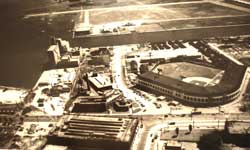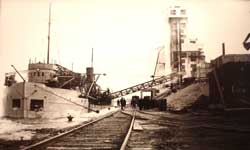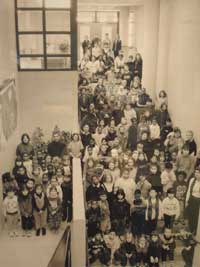 Anyone remember the old Maple Leaf Stadium that used to be on Lakeshore Blvd. at Bathurst Street? If you remember that old stadium, then you have been to the area of The Waterfront School. Built in 1997 on lands that used to house railway tracks and warehouses for the busy port and the Harbour Brick Company, the site was chosen in 1989.
Anyone remember the old Maple Leaf Stadium that used to be on Lakeshore Blvd. at Bathurst Street? If you remember that old stadium, then you have been to the area of The Waterfront School. Built in 1997 on lands that used to house railway tracks and warehouses for the busy port and the Harbour Brick Company, the site was chosen in 1989.
In the 1800’s The Board of Harbour Commissioners decided that a winter harbour was required along the western bay shore. The inner harbour at Queen’s Wharf was by then a busy industrial port for Great Lakes shipping. Queen's Wharf was also called into use in the days of the Niagara steamers all through the winter. Vessels ran to and from Toronto and Niagara throughout the winter season sailing from the Queen's Wharf. Queen’s Wharf provided the perfect spot and the city cribbed and filled in the water portion between Queen’s Wharf and the Northern pier at a cost of $ 10 000. But the Canadian Pacific Railway sent in a gang of workers one night and laid railway tracks and literally stole the property.
 Duncan Allen described Harbourfront as “approximately 100 acres of land along Toronto’s lakeside that was assembled by the Federal Government in the early 1970’s and presented to the people of Toronto as a “waterfront park”. The Harbourfront site itself extends from York Street on the east to Bathurst Street on the west and from Gardiner Expressway to the waterfront. The site is divided into five quays from east to west York, John, Maple Leaf, Spadina and Bathurst.” It is Bathurst Quay area that was chosen for the school.
Duncan Allen described Harbourfront as “approximately 100 acres of land along Toronto’s lakeside that was assembled by the Federal Government in the early 1970’s and presented to the people of Toronto as a “waterfront park”. The Harbourfront site itself extends from York Street on the east to Bathurst Street on the west and from Gardiner Expressway to the waterfront. The site is divided into five quays from east to west York, John, Maple Leaf, Spadina and Bathurst.” It is Bathurst Quay area that was chosen for the school.
Bathurst Quay was developed haphazardly. A lack of community services and several isolated buildings led to the development of a mixed use site including a community centre, daycare, and school to begin to address the needs of the community. The original community centre was established in 1991 and housed in a group of portables clustered at the foot of Bathurst Street.Children in the area were bused to one of seven schools out of the district. The school complex became the focus of a community needing a place to meet,talk, work together and educate their children in their own neighbourhood.

Waterfront School was born. We opened our doors in September 1997 to children from Junior Kindergarten to Grade 8. Designed by award winning architects Carruthers Shaw, our building has been featured in architectural magazines for its innovative design. Christopher Hume wrote in the Toronto Star: “Waterfront Public School………. Innovative and sensitive, it anchors the lakeside neighbourhood physically and socially. Both as landmark and community enhancer, it takes unused land and reintegrates it into the city. In other words, this is one of those rare buildings that transcends itself and whose contribution goes beyond merely fulfilling a program. In its own quiet way, it helps make Toronto a better place.”
In 2001 extensive renovations were completed to the building to accommodate City School Alternative Secondary School. Their school population is diverse and they service students in Grades 11 and 12 from all across the city.
Waterfront sits on an historic site.
Garrison Creek flowed in a large deep ravine with several tributaries, from north of St. Clair to Lake Ontario and emptied into the lake on the east side of the present school site. While buried underground now, a commemorative walkway including fossil imprints of marine life found in the creek was built beside the school at the original exit site.
Lieutenant John Graves Simcoe founded modern urban Toronto, the Town of York when he established Fort York in 1793. At that time, Garrison Greek had sparkling clear water and was famous for salmon fishing. The British built Fort York at the mouth of the creek to guard against possible American attempts to invade Canada. By 1880 development had polluted the creek and the City buried it in an underground sewer where it flows today. Today there is a Discovery Walk that follows the path of the creek through neighbourhood streets and parks terminating at Waterfront School.
Little Norway Park is situated on the west side of Bathurst Street directly across for the school’s playground. During the Second World War, Norway surrendered on June 10, 1940 but all through the summer of 1940 the Norwegian air force was regrouping in Toronto. Its name commemorates the World War II training base, used by the Norwegian Air Force that once existed on the site. "Little Norway," established on Toronto's waterfront in 1940 as a training base for the country's government-in-exile. In 2007, the Little Norway Memorial was opened by Norwegian Prime Minister Jens Stoltenberg, 20 years after King Olav V opened Toronto's Little Norway Park. Our students play soccer and have baseball games under the shadow of the Norwegian flag.
Directly to the south of Waterfront School, behind the Canada Malting silos, lies a little known park. The Toronto Irish Famine Memorial is hard to find, tucked away behind the silos. The park honours the Irish who fled during the famine of 1847. The 38,000 visitors overwhelmed the town of Toronto, then with a population of only 20,000. The poignant sculptures were created by Rowan Gillespie, who had sculpted a matching set seven years earlier in Dublin, Ireland.
To the north of the school is Lake Shore Boulevard which along with Kingston Road was previously designated as Highway 2. This was the prominent route between the Town of York and the fort and settlement in Kingston travelling along the shoreline of Lake Ontario.
Waterfront School is the last new school building built by the former Toronto Board of Education before amalgamation. The original Toronto Board of Education crest sits proudly on the wall at the main entrance to the school. Designed in 1949 by Alexander Scott Carter, a Canadian architect and authority on heraldry, the crest has many symbols. Two open books represent knowledge; walking gold lion for England; blue antique lamp with a red flame represents truth; and a beaver for Canada. For a full and rich explanation of the crest, please visit our school, see the crest and read the plaque so proudly displayed at the front entrance.
Which brings us back to Maple Leaf Stadium. It was located on the west side of Bathurst Street between Little Norway Park and Lakeshore Blvd. The scene of many sports events and the source of many memories for Toronto sports fans. It was dismantled, Queens Quay was constructed and the condos and City housing erected. Queen's Quay was originally commercial in nature due to the many working piers along the waterfront. It has been extensively rebuilt in the past two decades.
While we are a young school in years, we are rich in history and sense of community.